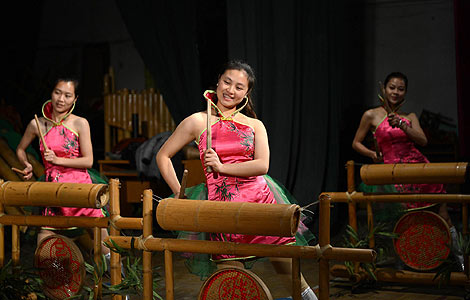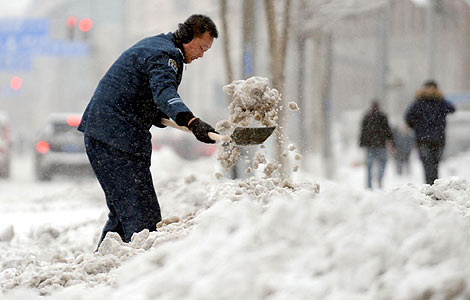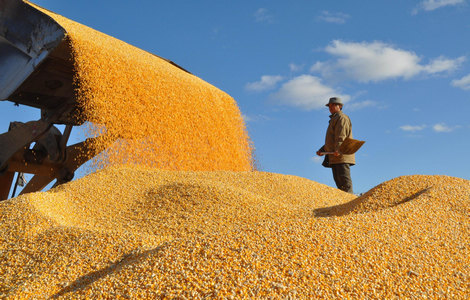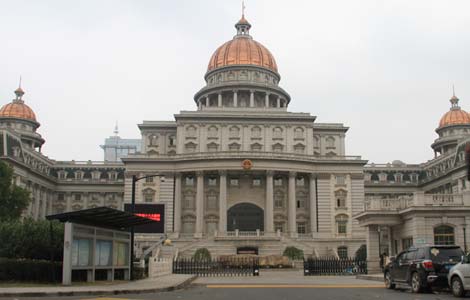
|
Crabs in a paddy field in Panjin, in Northeast China's Liaoning province. Thanks to technical and policy supports from the local government, Panjin's crab farmers have overcome many problems associated with raising crabs in northern China, where there are not as many ponds as in southern China. As a result, they turned to the rice fields, a move which proved to be very popular and successful. Provided to China Daily |
Northeast region farms start to challenge rivals from the south
September is the busiest season for Sun Xiuling. "I haven't slept for two nights. I just got free so I could wash my face with cold water to wake me up," said the bloodshot-eyed 50-year-old woman.
Sun, who lives in Hujia township, Panjin, in Northeast China's Liaoning province, is famous for breeding and trading crabs. Panjin is one of the three well-known sources for hairy crabs in China. And the only market in the country specializing in selling crabs is located in Hujia township.
Autumn is the best time to eat crabs. As a result, thousands of dealers across the country pour into the 24-hour Hujia market. Lines of trucks can stretch several kilometers even at 3 am.
"It's hard to catch crabs during the day. They come out at night. So usually we catch them at night and package them in boxes at daybreak," said Sun.
Her 20 square meter store in the market is filled with glass containers in which the crustaceans crawl over each other. Six workers are busy weighing and wrapping them. Outside her store, packed boxes are piled as high as two meters.
"This is just a small part of it. Most were sold at daybreak. I can sell more than 5,000 kilograms of crabs a day during this season," she said.
Besides the endless business, what makes Sun sleepless are two national awards she won on Sept 21 - the gold medal and the best germplasm (crab nursery) award in the Liaohe River Cup national freshwater crab contest.
"It's the first time I have won national prizes. It's not only praise for my products, but also an affirmation for Panjin crabs. It means that Panjin crabs have the same quality as the most famous hairy crabs from Yangcheng Lake in Jiangsu province or even more so," she said excitedly.
'Golden industry'
Sun started her career with crabs in the 1990s. Now she contracts more than 67 hectares to breed and farm the crustacean with annual output reaching about 100 tons.
She is not the only farmer now benefiting from the crab industry. In Panjin, about 120,000 people are engaged in the "golden industry", she said.
According to the Ocean and Fisheries Bureau of Panjin, the city's crab cultivation area was 100,000 hectares with an annual output of 51,000 tons, valued at 2.8 billion yuan ($441 million) in 2011. The city's crab production contributed more than 11 percent of local farmers' per capita income this year, said Han Yinglin, a divisional director for fisheries and seafood at the bureau.
"The industry contributes 1,400 yuan a year to farmers' annual incomes, accounting for 11.5 percent of their per capita income. It's really an industry that is filling our villagers' wallets," he added.
Bai Qingkui, who was a technician at a local official institution, quit his job to cultivate crabs in 1998. The number of his staff increased from one to more than 30 and his cultivation area expanded from just a few acres to 20 hectares. "I used to earn about 10,000 yuan a year but now I earn as much as 2 million yuan a year," the 52-year-old businessman said.
His company covers the entire industry chain, including breeding, cultivation and trading. "Thanks to the crab industry, I changed my bicycle to a car and changed my shabby cottage to a villa," he said.
"Taking Panshan county as an example, 78,000 people benefited from the industry. As the main crab producing area of Panjin, the county's crab output was 2.05 billion yuan in 2011, accounting for 10 percent of the country's total. At least 2,000 yuan of local farmers' annual per capita income come from the crab industry," said Yan Baiwen, head of the county's crab industry association.
Natural conditions
Panjin's aquatic wealth is inextricably linked with local natural conditions.
Located on the coast by the Bohai Sea, Panjin has a warm temperate and semi-humid continental monsoon climate. The annual average temperature is 8.3 degrees Celsius.
Also, the soil of the city is rich in trace elements and organic substances.
There are 21 rivers flowing through the city, which form a coastal and estuarine delta wetland ecosystem consisting of water, mudflats and reed marshes.
"Crabs are a migratory species. They spawn in the sea and grow in freshwater. Panjin has so many coastal wetlands blending with seawater and freshwater with brackish salinity of 2 percent to 3 percent," said Wang Wu, a veteran professor engaged in aquaculture research at Shanghai Ocean University.
The same root
Both Panjin crabs and their Yangchenghu relatives have the same name - Eriocheir sinensis, or Chinese mitten crab. They live in different environments. Panjin crabs are found in reed ponds or paddy fields. Those in Yangchenghu mature in lakes. Due to the different temperature, the former's growing period is shorter than the latter. As a result, Panjin crabs are usually smaller than their Yangchenghu relatives, according to Wang.
Both crabs may share the same megalopa, or final larval stage. According to the Ocean and Fisheries Bureau of Panjin, during the period of the 11th Five-Year Plan (2005-10), the city offered more than 40,000 tons of larval crabs to at least 20 cities and provinces, which accounted for 70 percent of the country's total supply.
"There are no significant differences between the two except their sizes due to different climates, water quality and other factors," Wang added.
"If you have to find something different between the two, Panjin crabs are usually heavier than the Yangchenghu crab if they are the same thickness, length and width," said Yan from the Panshan county crab industry association.
Culture contest
Why are Panjin crabs not as famous as Yangchenghu's although they are almost the same? asked Wang rhetorically.
"It's culture. The Yangchenghu crab wins because there are many stories associated with it, such as the origin of its name. This helped to form a kind of crab culture which easily spread and attracted customers' attention," Wang said.
"It's a pity that we didn't fully make use of crab legends in the past. We should learn from the people in the Yangcheng Lake area. Fortunately, our local government has undertaken a series of measures to change this situation," said Yan.
The Panjin government has held a crab culture festival annually since 2010.
Furthermore, it opened the only crab museum in North China on Sept 22 in the city. The museum uses a variety of ways, including pictures, specimens and video, to showcase the local crab culture and development of the industry.
Many crab stores are beginning to offer free handbooks on cooking methods or the technique for eating crabs to customers. Also, you can find sauces for cooking the crustacean and tools for eating it in the stores.
"Nowadays, we not only sell our products but also sell crab culture," crab businessman Bai said.
Technical support
Panjin's history of raising crabs dates back to the 1970s. In 1991, local people began to cultivate the crustacean in paddy fields. After years of trial and error, the local government helped crab farmers in Panshan county to overcome many technical problems so that farming crabs in paddy fields became popular on a large scale.
Moreover, cooperation with Shanghai Ocean University in Panjin led to the establishment of a new technology research center in 2011 to improve the output and quality of crabs.
The difference between paddy fields here and in other parts of the country is that those in Panshan county are surrounded by half a meter of plastic sheeting. From afar, the fields look like wide and narrow stripes. On the sides of the field the farmers plant soybean.
"A traditional rice row pitch is nine cun (about 30 centimeters). For the crabs, we changed it to six cun and three cun. As a result, we can guarantee the output of rice because the amount is unchanged but this method allows space for raising crabs," said Chen Weixin, head of Panshan Crab Technical Institute.
"This model allows paddies sufficient sunlight which can reduce insect damage, so we don't need to use pesticides. Also, crabs can clear weeds and their waste can improve soil fertility," she added.
"I can harvest rice, crabs and soybeans at the same time. The total profit amounts to 2,200 yuan for every one-fifteenth of a hectare, 800 yuan more than if I planted just rice. Moreover, the rice sells at a higher price than ordinary rice because it is grown without pesticides," Bai said.
Wang Wu summarized the so-called Panshan model as "1+1=5", namely, "Rice plus crab equals output increase plus food safety plus ecological security plus increase in farmers' income plus business efficiency."
In addition, due to its advantages, the Panshan model has been exported to more than 20 provinces and regions including Ningxia Hui autonomous region and Heilongjiang. The whole area is more than 87,000 hectares.
Brand building
"More and more customers like to choose Panjin crab now. In Hujia market, more than 100,000 people from all over the country come here to buy crabs every year. This is the brand effect," said Yan from the Panshan county crab industry association.
In 2011, the Panjin government registered all local crabs under the trademark "Panjin Crab".
"People like to buy Panjin crabs for their good taste and quality although it will be 10 yuan more expensive than other local brands," said Jia Yunsheng, a crab broker who has been in the business for 11 years in Hujia.
Most crabs are not sold in the market but by crab brokers such as Jia.
There are more than 6,000 crab brokers in Hujia township now. They travel around the country or even abroad to sell Panjin crabs.
"My customers will call me to order crabs and then I buy the crustacean from local raisers and send them to my customers by air, train or bus," Jia said.
"That's the traditional way of selling crabs. We are building an online marketing platform. It may be put into use in the near future," Han said.
Panjin crabs, especially larval crabs, are highly favored in Japan and Korea. Southeast Asia is becoming Panjin crab's latest market. In 2011, Panjin crab exports amounted to 2,000 tons.
Contact the writers at zhuchengpei@chinadaily.com.cn and liuce@chinadaily.com.cn.
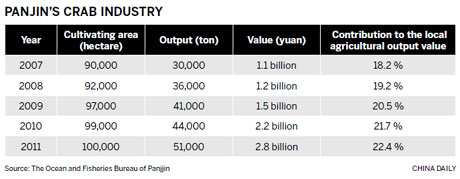
(China Daily 10/15/2012 page16)



